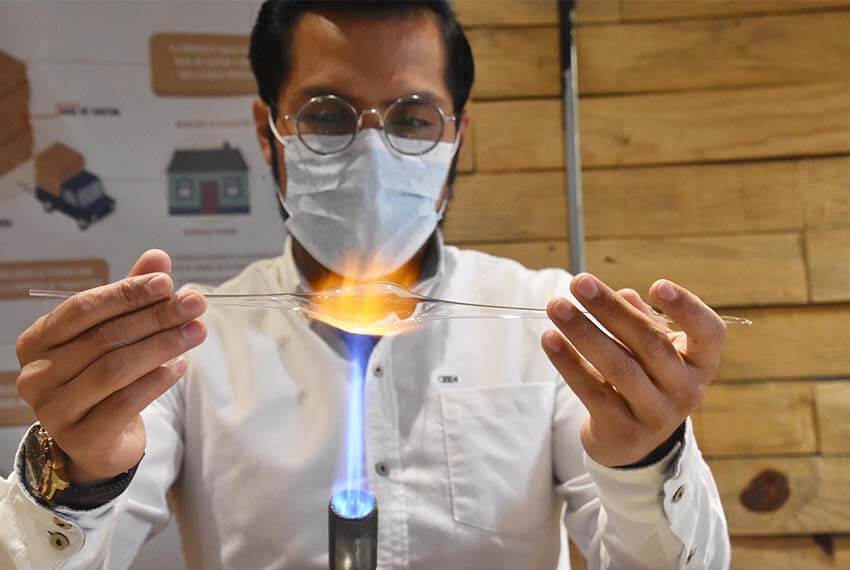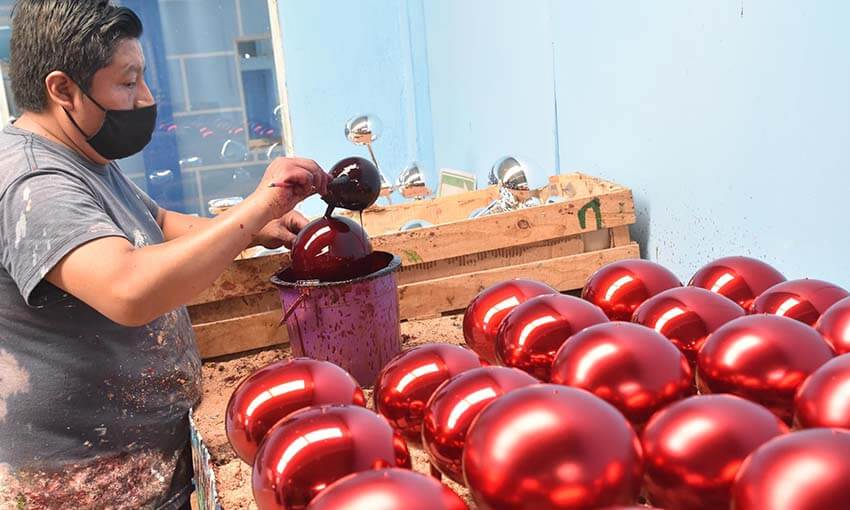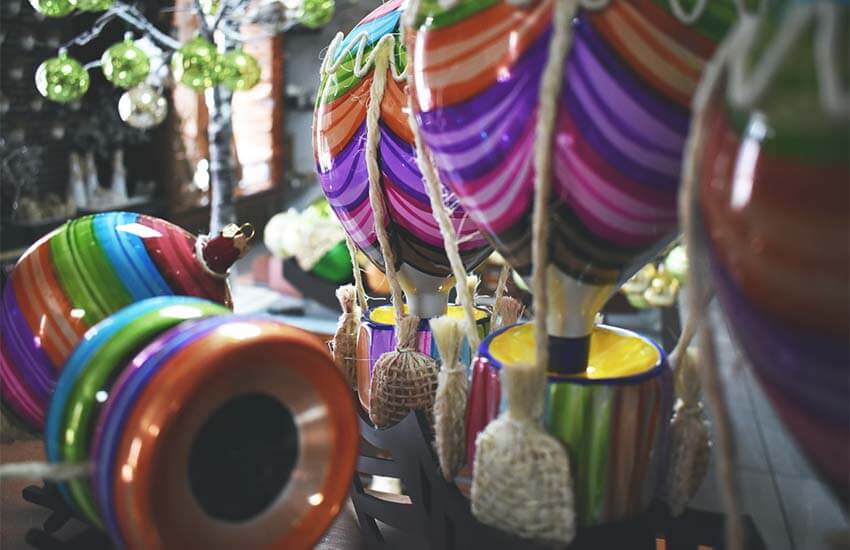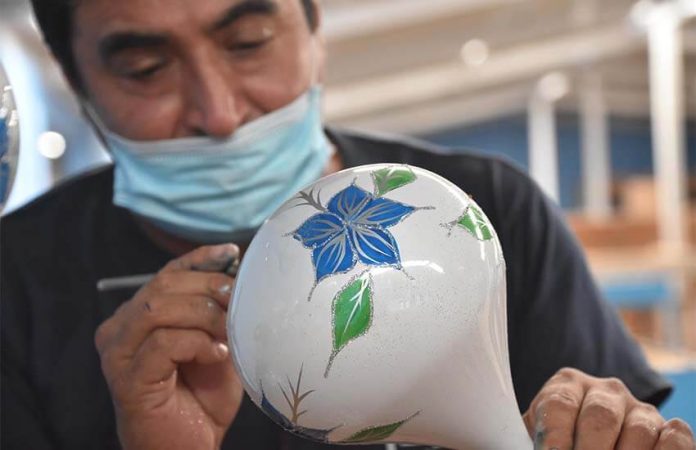With all the problems piling up in the world — worries about climate change and the continuing pandemic to mention just two of the biggest — it can be little tough to get into the Christmas spirit. But a trip to Chignahuapan, Puebla, can definitely help put you in the mood.
That’s because Chignahuapan, one of Mexico’s designated Pueblos Mágicos, located two hours north of Puebla city, boasts 400 stores and factories dedicated to making just one thing: hand-made artisanal Christmas ornaments, known in Mexico as esferas.
The art of making esferas was brought to Chignahuapan when Rafael Méndez Nuñez, a chemical engineer who had an interest in making ornaments, moved to Chignahuapan from Uruapan, Michoacán in 1966. Initially, the esferas that he made were very simple: round, silver and undecorated. Today, using the same techniques that Méndez pioneered, other artisans make ornaments that are much more elaborate.
Esferas today come in countless shapes, sizes and decorations. Some are simple bulbs painted in bright strips; some have snowflakes or other winter scenes; others are shaped like small tops; still others have been made to look like hot-air balloons.
The first step in making an esfera is transforming a long, narrow tube of glass into a globe or some other figure using a blowtorch. This is done by craftsmen known as globeadores.

“The glass we use is Pyrex, which we import from Germany,” said Josué Santos Galindo, who works at Esferas Campanita, a family-owned business started by Evodio Hererra and Arminda Olvera in 1998.
“One needs to know how much temperature to use, [and one] needs to control it,” Santos said.
The glass is heated and pulled by a globeador so that there are two thin tubes connected to a larger mass in the middle. The glass is ready to be shaped into a bulb when that mass is softened and turns orange. The end of one of the tubes is then heated and sealed.
“The difficult part is when the bulb is made,” Santos said.
This is done by gently blowing into the unsealed tube. “One needs to let the air in while turning the glass, only using the lips to blow,” he said. “It is difficult to control the air.”
Shoppers can try their hand at making a bulb at the store, working under the watchful eye of Santos or another employee. But it’s a difficult skill to do well; it could take as long as two weeks to learn how to make a perfectly round bulb.
Juanita Solano Cruz has worked as a globeadora for 27 years. The esferas she makes are much more complicated than a simple bulb.
With seemingly little effort, she’s able to expertly transform a single thin piece of glass into an elaborate esfera of five differently sized bulbs. To make each of the bulbs, she first heats a small part of the glass, blows into the tube to obtain the size she wants, heats another section, then blows another perfect bulb, continuing the process until she completes the esfera.
She laughed slightly when asked how long it would take to learn how to make something like that. “It would take about a month to learn to make the smallest one,” she said. “For a large one, one needs more experience. In about two years, a person would be an expert.”
Once a bulb’s made and cooled, it’s filled with a silver nitrate solution, dipped into warm water and gently shaken to evenly coat the bulb. This makes the esfera opaque and ready for the next step, which is painting.
About a 10-minute ride from Esferas Campanita is El Castillo de la Esfera, the largest maker of holiday ornaments in Mexico, founded by Javier Tirado Saavedra in 1993. José Romero Sánchez is a pintador (painter) who has worked there for 27 years. “It is a special paint,” he explained as he gently turned the bulb while pouring the color over it.
Although this may seem like a simple step, it’s not. “The important thing is to know how to turn the bulbs,” Romero said. On a typical day, he can paint 5,000 of them.

Once dried, the stem that’s still attached to the bulb is cut using a small emery stone. Once that’s done, the bulb’s ready to be decorated.
Eduardo Rueda Caballero sits at his workbench, focusing intently on the flowers he’s painting on a bulb. “I can decorate 60 in a day,” he said. To learn how to paint a bulb like the one he was working on takes about a week, he said. “Practicing daily.”
Nearby, Orlando Reyes painted something more complicated, el Nacimiento — a Nativity scene — on bulbs. He can make 100 of these over the course of three days, painting the scene in stages. “Although we take longer to make them,” said Carolina Vázquez, another pintadora, “we make them well.”
Both El Castillo de la Esfera and Esferas Campanita also make personalized esferas, painting whatever a customer requests on the outside or tucking a photograph on the inside. Small esferas go for as little as 50 pesos (US $2.50) per dozen, while the most expensive ones cost 500 to 600 (US $25 to $30) a piece.
“When people see esferas in a store, they do not know how much work goes into it,” said Santos. “This is why it costs more. If people knew how much work goes into it, they would value it more.”
Esferas Campanita is on the smaller side, employing 15 people in its store and — during the busy season from October through early January — another 15 in its workshop.
El Castillo de la Esfera is several times larger.
“Here, 200 families depend on the company,” said Arturo Amezcua Muñoz, who has worked there for three years as the director of online sales. “This includes salespeople, drivers, carpenters. One hundred people work in the factory.”
He said that the factory turns out “millions” of esferas a year, operating year-round. “We have to,” he said, “to prepare for this season.”
The business also offers tours of the factory. On a recent Sunday, 4,000 people passed through.
If you’re hoping to make a day of it in Chignahuapan, in addition to its multitude of stores selling esferas, has a lovely zócalo featuring a colorful gazebo. During the season, there’s a huge Christmas tree with performers decked out as Santas, Grinches and other characters.
There’s also the Basilica of the Immaculate Conception, a Baroque-style church with a beautifully painted facade and its 14-meter-tall carving of the Virgin Mary inside. For those seeking a bit more nature, there’s the Laguna Almoloya, the pueblo’s lake, as well as nearby waterfalls, rivers and hot springs.

It’s estimated that the workshops in Chignahuapan turn out 70 million esferas a year, every one of them made by hand — a laborious process but not one that’s going to change.
“It is important to make these by hand to preserve tradition and for employment,” Santos said. “We all have work. It helps people economically in Chignahuapan. The character of this pueblo is as a producer of hand-made ornaments.”
When asked if there were plans to mechanize the process in the future, he simply said, “No.”
• Esferas Campanita has one store in Chignahuapan while Castillo de la Esfera has four in the pueblo and another two in Mexico City.
Joseph Sorrentino, a writer, photographer and author of the book San Gregorio Atlapulco: Cosmvisiones and of Stinky Island Tales: Some Stories from an Italian-American Childhood, is a regular contributor to Mexico News Daily. More examples of his photographs and links to other articles may be found at www.sorrentinophotography.com He currently lives in Chipilo, Puebla.
